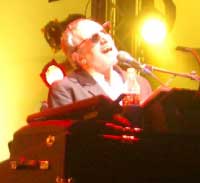Donald Fagen

In 1948, Donald Fagen was born and then raised in Passaic, New Jersey, and started playing piano as a child. He was deeply influenced by the jazz greats including Duke Ellington, Thelonious Monk and Horace Silver.
While in college, Fagen met bassist Walter Brecker and started what he has called "a bad jazz band," which included future comedic actor Chevy Chase.
Fagen and Brecker started a partnership, first writing songs for others to record. During this period they also toured as part of Jay and the Americans.
None of their songs for others were successful, so the pair decided to start their own band, which they called "Steely Dan." They wanted to create a progressive, intelligent, jazz influenced rock that had tongue-in-cheek or vague lyrics.
On the first Steely Dan albums, Donald Fagen played all keyboard parts, Becker played bass, and the band was fleshed out with full-fledged members. By their third album, the other members had left the band and Steely Dan was Fagan and Becker plus studio musicians.
Steely Dan developed a reputation for meticulous perfection, spending endless hours in the studio getting every track "just right." They also had developed asound making rock using "jazz" chords and extended harmomy and song structures.
In 1977, they released Aja, a milestone album in conception and production, and would be their biggest hit record.
Some of the many songs Steely Dan is known for include "Reelin' In The Years," "Rikki Don't Lose That Number," "Do It Again," "Kid Charlemagne," "Peg," "Deacon Blues," and Pretzel Logic."
Fagen released a solo album,The Nightfly, in 1982. Later in the 80's he composed for films. 1993's Kamakiriad was another solo record, but with Becker producing, it had a Steely Dan sound. In '94, Steely Dan reformed to tour for the first time in nearly 20 years.
In 2000 the pair made the Steely Dan album Two Against Nature, for which they won the Grammy for Album of the Year. Everything Must Go, another Steely Dan album, was released in 2003. Fagen released the solo album Morph The Cat in 2006.
Photo: Public Domain
